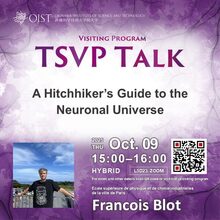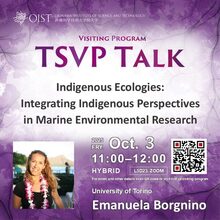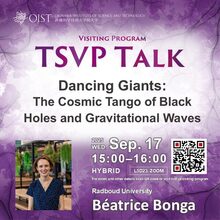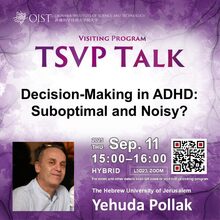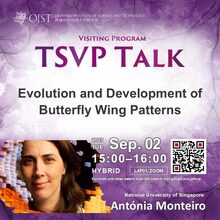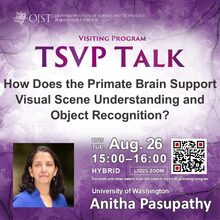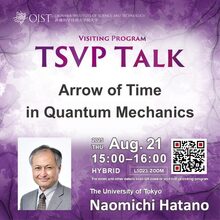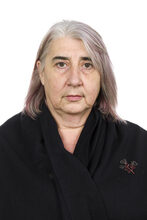Past Events
TSVP Talk:"A Hitchhiker’s Guide to the Neuronal Universe" by Francois Blot
2025-10-09TSVP Talk
Language: English (no interpretation).
Target audience: General audience / everyone at OIST and beyond.
Freely accessible to all OIST members and guests without registration (also via Zoom).
TSVP Talk: Indigenous Ecologies: Integrating Indigenous Perspectives in Marine Environmental Research
2025-10-03TSVP Talk
Language: English (no interpretation).
Target audience: General audience / everyone at OIST and beyond.
Freely accessible to all OIST members and guests without registration (also via Zoom).
TSVP Talk: Dancing Giants: The Cosmic Tango of Black Holes and Gravitational Waves by Béatrice Bonga
2025-09-17TSVP Talk
Language: English (no interpretation).
Target audience: General audience / everyone at OIST and beyond.
Freely accessible to all OIST members and guests without registration (also via Zoom).
TSVP Talk: "Decision-Making in ADHD: Suboptimal and Noisy?" by Yehuda Pollak
2025-09-11TSVP Talk
Language: English (no interpretation).
Target audience: General audience / everyone at OIST and beyond.
Freely accessible to all OIST members and guests without registration (also via Zoom).
TSVP Talk: "Evolution and development of butterfly wing patterns" by Antónia Monteiro
2025-09-02TSVP Talk
Language: English (no interpretation).
Target audience: General audience / everyone at OIST and beyond.
Freely accessible to all OIST members and guests without registration (also via Zoom).
TSVP Talk: "How Does the Primate Brain Support Visual Scene Understanding and Object Recognition?" by Anitha Pasupathy
2025-08-26TSVP Talk
Language: English (no interpretation).
Target audience: General audience / everyone at OIST and beyond.
Freely accessible to all OIST members and guests without registration (also via Zoom).
TSVP Talk: "Arrow of Time in Quantum Mechanics" by Naomichi Hatano
2025-08-21TSVP Talk
Language: English (no interpretation).
Target audience: General audience / everyone at OIST and beyond.
Freely accessible to all OIST members and guests without registration (also via Zoom).
Mini Course: Artiphysiology
2025-08-20 to 2025-08-22Lecturer: Professor Wyeth Bair, U Washington (current TSVP visitor)
This mini‑course is a series of three lectures, scheduled on August 20, 21, and 22 from 13:30 to 15:30.
Use the link below to register for this mini-course.
https://forms.office.com/r/ZrwJrNN69y
Contact gs-cp@oist.jp if you have any questions.
Mini - Course: An introductory course on Knots, contact structures, and open book decompositions
2025-08-12Lecturer: Dr. Sinem Onaran, Professor, Hacettepe University
This mini‑course is a series of four lectures, scheduled on August 12, 13, 19, and 20 from 13:00 to 15:00.
Use the link below to register for this mini-course.
https://forms.office.com/r/ZrwJrNN69y
Contact gs-cp@oist.jp if you have any questions.
Expository Talks by Dr. Dolors Herbera
2025-08-08Expository Talk by Prof. Dolors Herbera (Universitat Autònoma de Barcelona, Spain), as part of the Thematic Program TDA PARTI: Topological Data Analysis, Persistence And Representation Theory Intertwined.
Abstract: A theorem of Kaplansky states that, over any ring, projective module decompose as a direct sum of countably generated (projective) modules.




